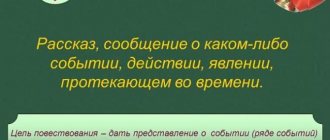Morphological analysis of the verb
Today we will answer such questions.
· What do we know about verbs?
· How to perform morphological analysis of a verb?
· What is the difference between oral and written reviews?
We remember that a verb is a part of speech that denotes the action of an object and answers the questions what to do? what to do?
The verb can be in the present, past or future tense.
In the present and future tenses, verbs change according to persons and numbers, and in the past tense - according to gender and numbers.
In a sentence, the verb is most often the predicate.
And today we will go to the parsing factory again! As always, first we get to the first workshop, where the general characteristics of the part of speech are examined.
Master Gosh's student just received a verb for analysis. Or rather, the sentence “Children listen to the teacher.”
– And why do they keep sending me whole sentences? - Gosha became depressed.
“This is all because we always consider parts of speech as part of a sentence,” explained master Pyotr Petrovich. – For example, in this sentence we will consider the verb listen
.
“I see,” Gosha nodded. – And now we need to determine the general meaning of this verb, right?
This means that we need to find out what this verb means. And understand what question he is answering.
So, if it's a verb, then it means action
.
Children
- what are they doing?
- listen
.
The verb answers the question what are they doing?
And now we immediately go to the second workshop, where we will examine the morphological features of our verb.
- Oh yeah! – Gosha nodded. – I know that some features of a verb are unchanged. Just what?
– First we must identify the initial form of the verb, its type and conjugation
“,” the master responded.
– These signs are different for each verb, they never change
.
- Great! - Gosha exclaimed. – So what is the initial form of a verb?
You should probably contact the technical information department. There they just opened the directory in the right place.
“I see,” Gosha nodded. - So, let's put the verb in the initial form. Our verb in it should answer the question what to do?
What to do? - listen. Initial form - listen
.
What can the information department report about the form of the verb?
Let's go back to the workshop and look at the question we pose to our verb. Listening
- what are they doing?
The action that our verb denotes is still happening. So this is an imperfective
.
Well, now we need to determine the conjugation.
What can the information department say about this?
Let's go back to the workshop. It turns out that the conjugation of a verb can be determined by its personal ending. We have the ending -yut, we see it right away. So they are listening
is a verb of the first conjugation.
– But what to do next? – Gosha was confused. – We looked at the signs that are constant for each verb. But the verb can appear in different forms. What does it mean?
– This means that the verb changes according to tenses, persons and numbers
.
And sometimes - by childbirth
, - answered the master.
“So we need to find out all these signs of a verb,” Gosha realized. - And first let's look at the time. What do they report from the information department?
We return to the workshop. Our verb answers the question what are they doing?
The actions it denotes are happening now.
That is, at the very moment of speech. This means that this verb is used here in the present tense
.
We are left with a face and a number.
“It’s not always a person and a number,” noted the information department.
But our verb is of the present tense, and therefore it will change according to persons and numbers.
Let's go back to the workshop and look at the verb.
It clearly answers the question what are they doing?
This means that here the verb is used in the
third person plural
.
And now we can move on to the next workshop, where the role of verbs in a sentence is considered.
Children
what are they doing?
- the teachers listen
.
In a sentence, the verb is the predicate
.
Now we can move to the last workshop - the finished products workshop. We need to bring together everything we have learned about our verb.
Listen is a verb. Firstly, it denotes action: children (what are they doing?) listening.
Secondly, it has morphological characteristics: the initial form is to listen, imperfect form, first conjugation, here used in the present tense, in the third person, in the plural.
Thirdly, the sentence is a predicate.
The children (what are they doing?) are listening.
And now we have a sample of the morphological analysis of the verb. But, of course, this is an example of oral analysis. This is what a written review will look like.
So, to parse the verb...
· We must first give the part of speech a general description.
· Then we determine the initial form of the verb, find out what type of verb it is and what conjugation it belongs to.
· Then we determine the tense, person or gender and number of the verb.
· Finally, we indicate the function of the verb in the sentence.
Now let's practice a little!
Next week we will be welcoming guests.
Let's look at the verb
we will meet.
We will meet
- verb. Firstly, it denotes an action: we (what will we do?) will meet.
Secondly, it has morphological characteristics: the initial form is to meet
, imperfect form, first conjugation, here used in the future tense, in the first person, in the plural.
Thirdly, the sentence is a predicate.
We (what will we do?) will meet.
Please note that our verb has the form of the complex future tense, like all imperfective verbs. Therefore, we determine person and number by the auxiliary verb. And we emphasize two verbs together!
And now in Kolya’s sentence I watched an interesting film
Let's look at the verb
looked
.
Looked - verb.
Firstly, it denotes an action: Kolya (what did he do?) looked
.
Secondly, it has morphological characteristics: initial form - see
, perfective form, second conjugation, here used in the past tense, masculine, singular.
Thirdly, the sentence is a predicate.
Kolya (what did he do?) looked
.
Note. Verb to look
– an exception, it is of the second conjugation.
Therefore, the verb formed from it to look
is also of the second conjugation.
And further. Instead of person, we noted gender because in the past tense verbs change according to gender.
I will definitely remember this rule!
Let's look at the verb
I will remember
.
I'll remember
- verb.
Firstly, it denotes an action: I (what will I do?) remember
.
Secondly, it has morphological characteristics: the initial form is remember, perfect form, second conjugation, here it is used in the future tense, in the first person, in the singular.
Thirdly, the sentence is a predicate.
I (what will I do?) remember
.
Please note the differences between written and oral discussions.
What do we need to remember today?
· To analyze a verb, we must first give the part of speech a general description.
· Then we determine the initial form of the verb, find out what type of verb it is and what conjugation it belongs to.
· Then we determine the tense, person or gender and number of the verb.
· Finally, we indicate the function of the verb in the sentence.
Plan (sample) of morphological analysis of an adverb
| After the thunderstorm the air smelled fresh. | |
| Analysis plan | Sample oral debriefing |
| I. Part of speech. General meaning. Question for the word being analyzed. | I. Smelled (how?) fresh - adverb. Indicates an action sign. II. Significant, definitive;
III. Fresh (how?) is a circumstance. |
II. Constant morphological characteristics:
| |
| III. Inconstant features Degree | |
| IV. Syntactic role | |
| Sample written analysis | |
| Fresh - an adverb (smelled like?), denotes a sign of action, n. f. fresh, significant, course of action, unchangeable, circumstance. | |
Let us give examples of how to perform morphological analysis of an adverb depending on its belonging to a certain semantic category and on its grammatical form.





